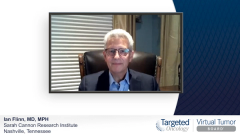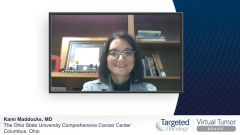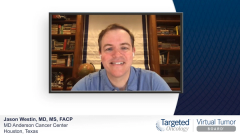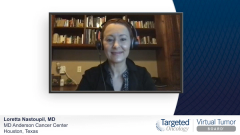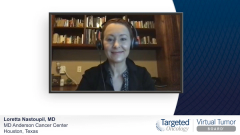
Case 1: Outcomes in Chemotherapy-Treated Patients With DLBCL
Loretta Nastoupil, MD:This patient was started on R-CHOP [rituximab, cyclophosphamide, doxorubicin hydrochloride, vincristine sulfate, and prednisone] therapy. FISH [fluorescence in situ hybridization] was negative for rearrangement of BCL6, BCL2, and C-MYC. She completes 6 cycles of therapy. She undergoes a posttreatment PET [positron emission tomography] and it demonstrates a complete response by Deauville, and with a Deauville score of 2. Ten months after completion of therapy, however, she complains of fever, night sweats and back pain and has a palpable lymph node in the left groin, which was discovered on physical exam. She undergoes restaging with PET and CT and is found to have a new left inguinal node, and increase in size of a residual node as well as multiple metabolically active lesions and lymph nodes in the retroperitoneum, the abdomen and the pelvis. A biopsy is pursued, and it confirms recurrent diffuse large B-cell lymphoma [DLBCL].
Kami Maddocks, MD: Now we’re back to our 63- … 64-year-old patient, relatively healthy, completed 6 cycles of therapy, had a CR [complete remission] to therapy but relapses in less than a year. What is the prognosis for a patient like this?
Loretta Nastoupil, MD:Based off of the CORAL study [NCT00137995] we know that patients who progressed within 12 months of CHOP-based chemotherapy, the outcomes with standard therapy such as salvage and high-dose therapy, autologous stem-cell transplant, are poor and only 20% of patients are likely to have a good outcome. This is a patient that falls into that category of poor prognosis with standard chemotherapy options.
Now we have other options at our disposal. We have trials that are enrolling, particularly with high-risk patient population, looking at CAR [chimeric antigen receptor] T[-cell] versus salvage and high-dose transplant, that would be an option that I would pursue in this setting.
Jason Westin, MD, MS, FACP: I would echo what Dr Nastoupil just said, that in that CORAL study the EFS, the event-free survival, at 1 year for those patients that had Rituxan [rituximab] and relapse was 25%. That’s kind of a historical benchmark we’re up against. And CAR T-cells are exciting but they’re not yet proven in the second line, so those studies hopefully will read out in the coming years, but as of now it’s a poor standard of care we have for salvage chemotherapy and transplant.
Kami Maddocks, MD: Ideally, this is a patient we’re looking at getting on a trial, but right now our standard outside of a trial is the salvage chemotherapy and autologous stem cell transplant if they respond.
Loretta Nastoupil, MD:The patient receives 2 cycles of R-ICE [rituximab, ifosfamide, carboplatin, and etoposide phosphate], and PET scan after 2 cycles demonstrates disease progression. They had a progression of it within 12 cycles of their frontline R-CHOP therapy. … Based off … a retrospective analysis, including data from the CORAL study from Mayo and from MD Anderson, we know that patients who have either primary refractory disease, or refractory to second-line, or progress within 12 months of autologous stem-cell transplant, their outcome in the era of chemotherapy-based approaches was quite poor.
Now I must note that this was prior to the approval of CAR T-cell therapy; it was prior to the approval of targeted therapy such as polatuzumab, tafasitamab, and selinexor, but this just highlights that in the era of rituximab and CHOP-based frontline treatment, patients who failed to achieve a meaningful remission are facing poor outcomes.
Transcript edited for clarity.



